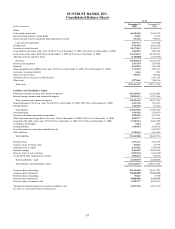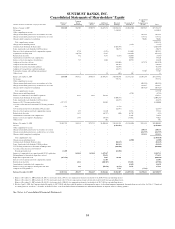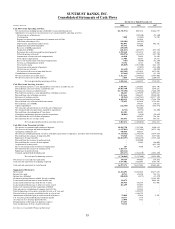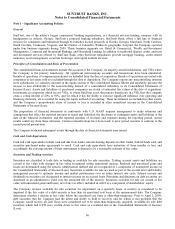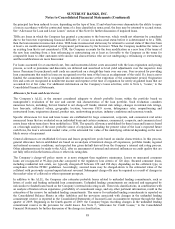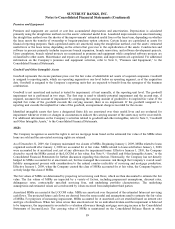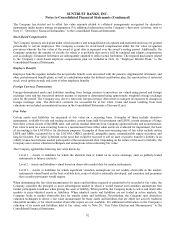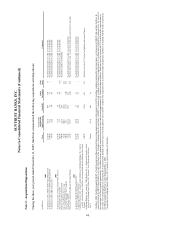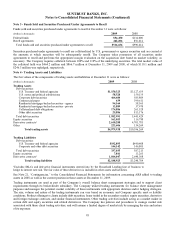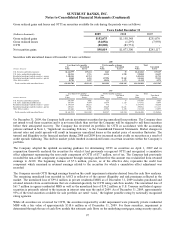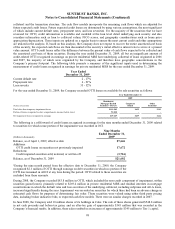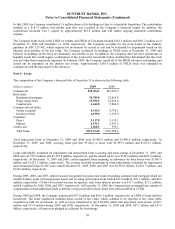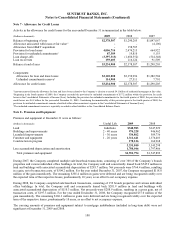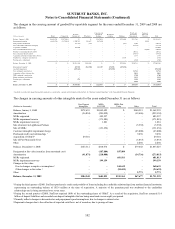SunTrust 2009 Annual Report Download - page 109
Download and view the complete annual report
Please find page 109 of the 2009 SunTrust annual report below. You can navigate through the pages in the report by either clicking on the pages listed below, or by using the keyword search tool below to find specific information within the annual report.SUNTRUST BANKS, INC.
Notes to Consolidated Financial Statements (Continued)
Accounting Policies Recently Adopted and Pending Accounting Pronouncements
In June 2009, the FASB issued an update to ASC 105-10, “Generally Accepted Accounting Principles”.This standard
establishes the ASC as the source of authoritative U.S. GAAP recognized by the FASB for nongovernmental entities. The
ASC is effective for interim and annual periods ending after September 15, 2009. The ASC is a reorganization of existing
U.S. GAAP and does not change existing U.S. GAAP. The Company adopted this standard during the third quarter of 2009.
The adoption had no impact on the Company’s financial position, results of operations, and EPS.
In June 2009, the FASB issued ASU 2009-16, an update to ASC 860-10, “Transfers and Servicing,” and ASU 2009-17, an
update to ASC 810-10, “Consolidation”. These updates are effective for the first interim reporting period of 2010. The update
to ASC 860-10 amends the guidance to eliminate the concept of a QSPE and changes some of the requirements for
derecognizing financial assets. The amendments to ASC 810-10 will (a) eliminate the exemption for existing QSPEs from
U.S. GAAP, (b) shift the determination of which enterprise should consolidate a VIE to a current control approach, such that
an entity that has both the power to make decisions and right to receive benefits or absorb losses that could potentially be
significant to the VIE will consolidate a VIE, and (c) change when it is necessary to reassess who should consolidate a VIE.
The Company has analyzed the impacts of these amendments on all QSPEs and VIE structures with which it is involved.
Based on this analysis, the Company expects to consolidate its multi-seller conduit, Three Pillars, and a CLO entity. The
Company will consolidate these entities because certain subsidiaries of the Company have significant decision-making rights
and own VIs that could potentially be significant to these VIEs. The primary balance sheet impacts from consolidating Three
Pillars and the CLO on January 1, 2010, will be increases in loans and leases, the related allowance for loan losses, LHFS,
long-term debt, and other short-term borrowings. The consolidations of Three Pillars and the CLO will have no impact on the
Company’s earnings or cash flows that result from its involvement with these VIEs, but the Company’s Consolidated
Statements of Income/(Loss) will generally reflect a reduction in noninterest income and an increase in net interest income
and noninterest expense due to the consolidations. For additional information on the Company’s VIE structures, refer to
Note 11, “Certain Transfers of Financial Assets, Mortgage Servicing Rights and Variable Interest Entities,” to the
Consolidated Financial Statements.
The combined impact of consolidating Three Pillars and the CLO on January 1, 2010 were incremental total assets and total
liabilities of approximately $2 billion, respectively, and an insignificant impact on shareholders’ equity. No additional
funding requirements with respect to these entities are expected to significantly impact the liquidity position of the Company.
Upon adoption, the Company consolidated the assets and liabilities of Three Pillars at their unpaid principal amounts and will
subsequently account for these assets and liabilities on an accrual basis. Upon adoption, the Company consolidated the assets
and liabilities of the CLO based on their estimated fair values and made an irrevocable election to carry all of the financial
assets and financial liabilities of the CLO at fair value. The pro forma impact on certain of the Company’s regulatory capital
ratios as a result of consolidating Three Pillars and the CLO is not significant.
The Company does not currently believe that it is the primary beneficiary of any other significant off-balance sheet entities
with which it is involved; however, the accounting guidance requires an entity to reassess whether it is the primary
beneficiary at least quarterly. The Company does not currently expect to consolidate additional VIEs in future periods.
In January 2010, the FASB voted to finalize an ASU that would defer the amendments to ASC 810-10 for certain investment
entities that have the attributes of entities subject to the “Investment Company Guide” and for MMMF that comply with or
operate in accordance with requirements that are similar to those included in Rule 2a-7 of the Investment Company Act of
1940. Certain of the Company’s wholly-owned subsidiaries provide investment advisor services for various private
placement and publicly registered investment funds. The Company expects that the deferral will apply to all of these funds.
93


